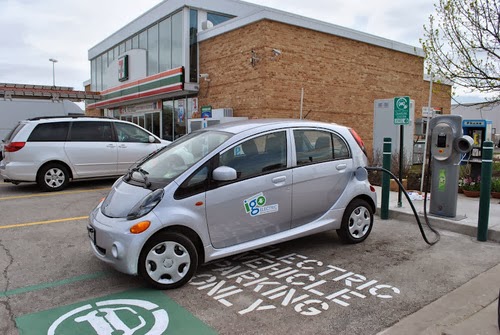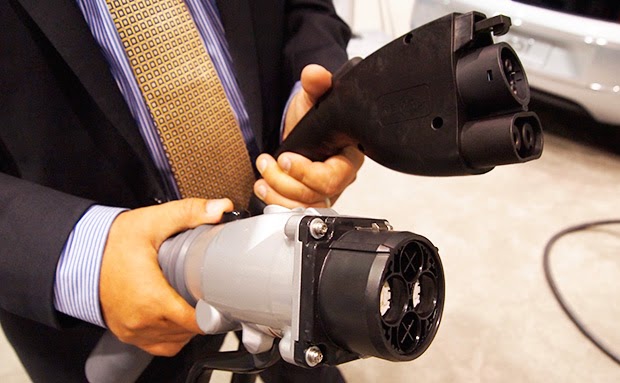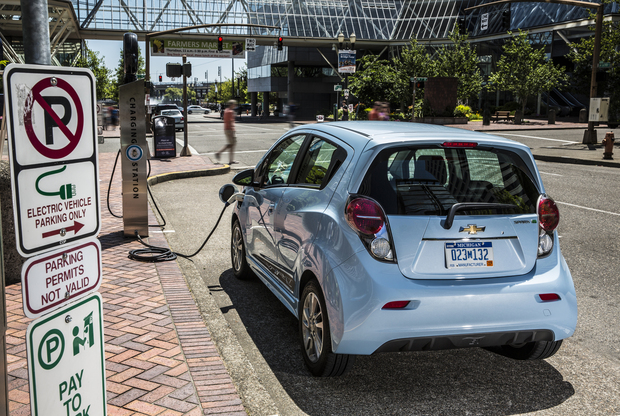What if it’s time to buy a new car, what do you choose? Thanks to lithium-ion battery technology, we now have a new drive-train choice. Rather than being limited to variant of gasoline engined vehicles, we can now buy electrified cars or motorcycles. Assuming you’ve already chosen to go electric (in some form), how do you choose between the models and manufacturers?
We’re only four years into the project of electrifying our cars, motorcycles and trucks, but there’s already a couple dozen models targeted to the average consumer. Well, in California; because some models are only sold in California.
It’s important to remember that the dollars you spend on one widget versus another widget is your vote. All those years where we couldn’t even buy an electric car were years we couldn’t even vote on electrified transportation. But, now we can cast that vote. It’s always a good idea to purchase wisely.
Perhaps the most important step is to honestly assess your real needs.
 |
| Tesla Model S fully loaded easily over $100K Widely voted to be best car ever made |
There’s a big difference between perceived needs and real needs. You may ~~~WANT~~~ that Tesla Model S because it’s such an awesomely perfect car. Oh, and the P85+ version out-accelerates a Porsche. But do you really need it? Can you even afford it?
Early in my exploration of electric vehicles I kept a diary of my driving, and when I bought gasoline. How many of us just drive around blissfully unaware of how far we drive? Or even of how often we buy gasoline? Or the fuel cost to go to a given place? What I learned from logging my driving was that my commute (at the time) was over 70 miles round trip, and that I often spent an hour driving each way. Shortly afterwards I moved to a place closer to the office, getting a drastically shortened commute time, reduced gasoline consumption, and improved quality of life.
Before buying an electric car, spend a couple months tracking your actual driving. Study where you go and how often.
The main thing to learn is your average daily driving, and how often you drive further than that. The average U.S. driver travels less than 40 miles a day, meaning most of the electrified cars, typically having an 80ish mile range, are far more than adequate.
That’s the average – it’s YOUR daily driving needs you have to satisfy. That’s why YOU must study YOUR driving patterns.
The data you gather will help you gauge which electrified car is for you. If you’re honestly driving 200 miles a day, a Tesla Model S will be your only choice, for example. But if you’re driving 60 miles a day, or less, any of the fully electric cars will work. If you frequently take long trips a plug-in hybrid might be a pragmatically good choice.
The next thing to consider is how good is your local electric car charging infrastructure.
Most people will be charging their car at home. This is one of the advantages of charging an electric car at home. The car is always fully charged every morning, and you don’t have to stop somewhere for refueling. Well, if you can charge at home, and not all of us can do so.
On the other hand, charging only at home means your electric travels are limited to a circle around your house. Charging at the office gives a little more flexibility. For longer trips on electricity you’ll need to use a public charging station.
The public charging stations are owned and operated by several “charging networks”. Each publishes their own maps and smart phone apps listing their stations. While each of the apps are straightforward to use – the stations are shown as pins on a map – it’s inconvenient to keep flipping from one map/application to another to figure out which is the closest station.
The PlugShare![]() app has data on all the charging networks in one map, making it easy to find the closest charging station no matter the charging network.
app has data on all the charging networks in one map, making it easy to find the closest charging station no matter the charging network.
What are your frequent destinations? What’s the closest charging station to each? To which networks do the charging stations belong? Join those charging networks.
What if your mix of destinations and charging stations doesn’t fit into the 80ish mile range of the typical electric car? The solutions are: public charging stations, public fast charging stations, or driving a plug-in hybrid.
You need to understand charging speed, and the difference between level 2 charging and fast charging.

![]() Refueling an electric car is different than a gasoline car. With gasoline the refueling process takes less than 5 minutes, and you get over 300 miles of range. Effectively you’re gaining about 3600 miles of range per hour of gasoline fueling.
Refueling an electric car is different than a gasoline car. With gasoline the refueling process takes less than 5 minutes, and you get over 300 miles of range. Effectively you’re gaining about 3600 miles of range per hour of gasoline fueling.
Electric cars don’t do this. Yet.
That electric cars don’t refuel as quickly as gasoline isn’t the kiss of death that the range anxiety proponents say it is. Typical daily driving needs are easily handled even with the slowest of charging methods.
The charging rates are described by “level 1,” “level 2” and so on.
Level 1 charging is what you get out of a typical 120 volt household power outlet. It’s 120 volts at about 12 amps, for about 1.4 kilowatts. That works out to 4-5 miles of range gained per hour of charging. While that’s pretty slow, if you plug the car in at 6pm when arriving at home, by 7am the next morning it will have gained over 60 miles of range.
Level 2 charging runs at 240 volts, often at 30 amps, for about 6 kilowatts charge rate. The rule of thumb says the car gains 20-25 miles of range per hour of charging. This is still fairly slow but is perfectly adequate if your car is going to be parked for several hours anyway, like at home or at work.
 |
| Fast charging station in Chicago |
DC Fast Charging is not so widely deployed and is frequently mis-named “level 3” when it’s actually “DC Level 2”. Where all electric cars support level 2 charging, not all of them support DC Fast Charge. The ones which do gain over 100 miles of range (or more) per hour of charging. The Tesla cars gain as much as 300 miles of range per hour of charging.
Getting back to your local charging infrastructure, how many DC Fast Chargers are near you? Are there plans to build more? And, unfortunately, you have to consider what kind of fast charging system is available.
 |
| Left: CHAdeMO Right: CCS |
Unfortunately there are three types of DC Fast Charging (DCFC) available, and the automotive industry is dragging their feet on straightening out the incompatibility.
CHAdeMO comes from Japan and is supported by the Nissan Leaf, Mitsubishi i-MiEV, and the Kia Soul EV. CHAdeMO is very widely deployed, and has been in use since 2008. The Combined Charging System is a newcomer, and there are very few CCS cars on the market. This should change since most of the automakers have voiced support for CCS. Tesla Motors has its proprietary Supercharger system, and is building charging networks in North America, Europe and China.

That is, a lot of naysayers talk about the price premium an electric car. For example the gasoline powered Chevy Spark runs about $14,000 and the 2014 Chevy Spark EV costs nearly $30,000.
The government tax incentives closes the gap on the price, some.
But, electricity is a lot cheaper a fuel than gasoline. The more you drive on electricity the more you save on fuel cost. The way to calculate this is the cost of electricity or gasoline to travel a given distance.
As long as you’re charging at home, the cost per mile of distance traveled is cheaper on electricity than gasoline. Of course that depends on both local electricity rates and local gasoline prices.
The last point to consider is which automaker is most serious about electrified vehicles.
By now you may have figured out I’m the boring guy who focuses on practical details. Rather than judge cars by how nice they look, I’m judging them on environmental footprint, utility, and price.
 |
| Fiat 500e |
The Fiat 500e is a beautiful car, fun to drive, and can flit around city traffic with ease. But Fiat has made it clear they aren’t serious about electric cars. Fiat’s CEO recently complained they were losing over $14,000 per car they sold, and begged us to please stop buying the 500e.
Some of the automakers are making fine electric cars, but selling only the minimum necessary to earn the ZEV credits in California necessary to keep selling gasoline cars in California. We call those Compliance Cars, built solely for compliance with California’s ZEV mandate.
Some automakers are pretty serious about building and selling electrified cars. Getting back to that idea of voting with our dollars, doesn’t it make sense to buy from an automaker who’s seriously electrifying their cars?
These are the automakers showing the most serious intentions over electrified vehicles:
 |
| Kia Soul EV |
Tesla Motors is only sells electric cars. The company is clearly on a mission to change the transportation system. The Tesla Model S, while being very expensive, is taking a significant share in the luxury car market.
The Nissan-Renault Alliance is the other leader in electric vehicle sales. Both are building electric vehicle charging infrastructure, selling several models, and have generated sales of perhaps 200,000 electric vehicles.
BMW has just begun selling their first electric vehicle, the i3, and a plug-in hybrid sports car, the i8. Sales are occurring across the U.S. and in Europe, and manufacturing is running at a pretty good rate. The company went to the trouble of developing an affordable carbon fiber manufacturing process, to reduce weight. Before the i3 the company built two vehicles, the Mini-E and ActiveE, as prototypes to understand their customers real needs.
GM makes the Chevy Volt, Caddilac ELR, and Chevy Spark EV. I used to consider the company as being very serious about electrified vehicles. But, the ELR and Spark EV are both selling in minuscule quantities, and the Volt’s sales have been surpassed by cars from other makers. This doesn’t show serious intent for electrified vehicles. Maybe they’re waiting for the Volt 2.0 to make a serious push?
Kia is just entering the electric car market with the Kia Soul EV. While it’s in limited production and only being sold in California, for its first model year, the company has made a couple moves demonstrating seriousity. They’re building a network of fast charging stations at Kia dealers, and indications are that next year they’ll ramp up production and sales. Additionally, the Soul EV is getting excellent reviews in both Europe and North America.
Ford’s Focus Electric is selling in minuscule quantities making many dismiss Ford’s efforts as not being serious. I see a couple things in Ford’s favor that outweigh their intransigence towards the Ford Focus Electric. 1) The company has an interesting long-term strategy, The Power of Choice, in which customers choose between drive trains just as they choose between leather or cloth seats today. The strategy isn’t fully realized yet, but the result will be to make any Ford vehicle available in gasoline/hybrid/plug-in-hybrid/electric versions. 2) Add together sales of the Fusion Energi and the C-MAX Energi, and Ford is outselling the Chevy Volt.
- Highway design could decrease death and injury risk, if “we” chose smarter designs - March 28, 2015
- GM really did trademark “range anxiety”, only later to abandon that mark - March 25, 2015
- US Government releases new regulations on hydraulic fracturing, that some call “toothless” - March 20, 2015
- Tesla Motors magic pill to solve range anxiety doesn’t quite instill range confidence - March 19, 2015
- Update on Galena IL oil train – 21 cars involved, which were the supposedly safer CP1232 design - March 7, 2015
- Another oil bomb train – why are they shipping crude oil by train? – Symptoms of fossil fuel addiction - March 6, 2015
- Chevron relinquishes fracking in Romania, as part of broader pull-out from Eastern European fracking operations - February 22, 2015
- Answer anti- electric car articles with truth and pride – truth outshines all distortions - February 19, 2015
- Apple taking big risk on developing a car? Please, Apple, don’t go there! - February 16, 2015
- Toyota, Nissan, Honda working on Japanese fuel cell infrastructure for Japanese government - February 12, 2015




















